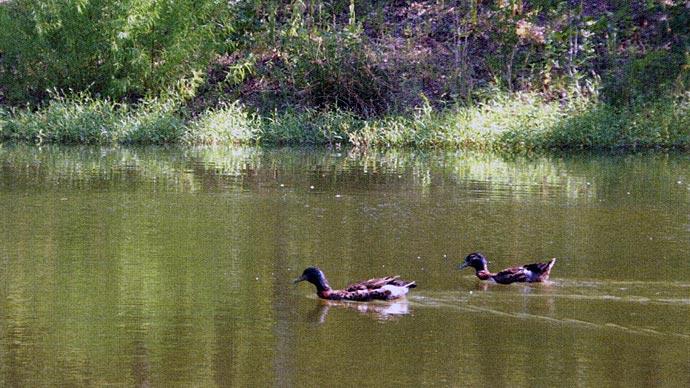
During the fall semester of 1993 at college, I fell deeper in love with bass fishing. Nineteen years of baseball had taken its toll on my body. It was November, and I was three weeks away from major shoulder surgery. Since I was no longer the starting catcher and would be relinquishing my scholarship at the end of the semester, I spent as much time at The Fishin' Fools, the local tackle store, as much I could.
My school, The Master's College, was located in Santa Clarita, approximately 30 miles north of Los Angeles. I don't believe it would take too much thinking to conclude that one of California's legendary big bass haunts is only a little more than nine miles further north: Lake Castaic.
After school was over, I would drive to the Castaic Mobile Mini Mart and watch people bring in some very healthy largemouth bass. I wish that I had a boat to go out on this lake searching for "monster bass."
I met a guy named "Zank" at The Fishin' Fools by my school. John Viazanko (pronounced Vee-uh-zank-oh) is a guide and lure designer. He also has been known to win minor money fishing tournaments on numerous Southern California reservoirs. "Zank" showed me a technique that had nothing in common with typical Southern California finesse fishing lore. Surprisingly, this technique did not include a super light line, a split shot, or three-inch hand-poured plastic worms. It was the most incredible thing I had seen at the time and is a technique that has done well for me on several occasions since.
We were on the water early that crisp fall day. We spent most of the morning working to pattern fish in 90- to 120-feet of water. We spent a lot of time split shot, but we also spooned for a while, managing to boat two bass and a beautiful 12-pound anchor with a 30-foot rope. The morning was fun, though a bit slow. Then, as if on cue, the breeze started to blow.
The wind blew out of the south, straight over the top of the dam and up into the famous Castaic Fishing arm, which stretches northeast from the dam. To the back of the fishing, the arm is an area that looks like a canyon river, with steep canyon walls that plummet hundreds of feet down to the water's edge.
Here we found what Zank called "popcorn bass." The surface was alive with activity. Schooling bass had pinned a ball of shad in the back of the fishing arm and were aggressively feeding on the surface to the bottom in 50- to 60-feet of water. "Zank" described what was going on in that little back creek area. The wind had blown the shad into the back of the creek; the bass had followed and were gorging themselves on the baitfish. Each bass we caught expelled numerous shad as they came to the surface.
I asked John if we were going to spoon. He said no because he wanted to stay back away so we wouldn't spook them. John reached into his rod locker and pulled out two 6-foot 6-inch baitcasting rods with 12-pound test Maxima Ultragreen fishing line. The lures were small; 3/16 oz. or smaller teardrop-shaped baits with a small Colorado spinner blade on the back and a treble hook in the bottom.
The lure was called "Lil' George." Zank told me to cast the lure beyond the school and allow it to sink to the bottom on a semi-slack line. When the bait hit bottom, I was to rip the bait up with my rod tip and begin slowly rolling the bait back to the boat.
The strikes would occur as the lure was slowly rolled through the school of feeding bass. It seemed that the lure would appear from behind the fish, and they would react instinctively to the compact lure, and the fight would be on. The strikes that day were just pressure bites; we never really felt any fish thump the lure. We would feel the rod load up. The hook set was just a reel set, similar to a crankbait. If we tried to set the hook with force, the hooks would tear loose. That afternoon was an absolute blast. We caught over 40 fish; Zank caught at least 25, and I boated 18.
Over the years, I have used this type of lure to catch fish at Folsom Lake and Oroville. I'm sure that the bait would be effective at other similar places throughout California and The West. The fish are never huge, I think the biggest we landed that day was around 2 ½ pounds, but those schoolies can sure make or break a tournament day. They can also make for a lot of fun.
While this technique remains my favorite, I have also managed to catch fish by yo-yoing the lure. Cast the lure out and let it sink to the bottom on a semi-slack line. Once the bait hits bottom, rip it up about three feet and let it fall back down. Again, maintain enough contact with the bait to feel a strike, but not too tight so that the bait falls too far toward you. The strikes will mainly come during the fall, so be prepared to feel a slight tick, or see your line jump as the bait sinks.
Look for areas where baitfish tend to congregate. Breaks are excellent for the yo-yo method and flats that have a lot of bait spread out across the bottom. The backs of coves or creeks are suitable for the slow roll method and long main lake points where bass feed.
Try this technique; it was made that day for "Zank" and me years ago and has improved many other days. I bet you won't be disappointed.




